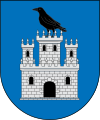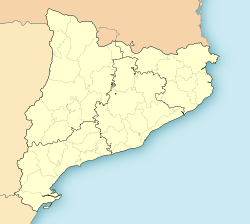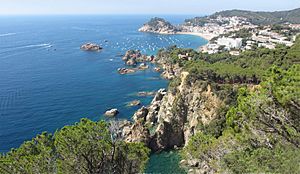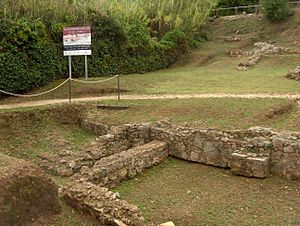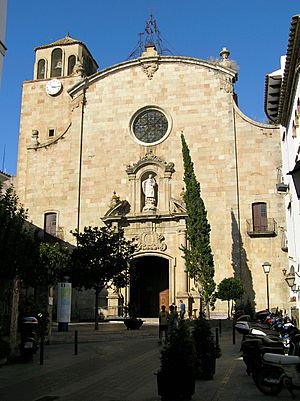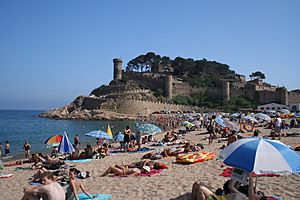Tossa de Mar facts for kids
Quick facts for kids
Tossa de Mar
|
|||
|---|---|---|---|
|
Municipality
|
|||
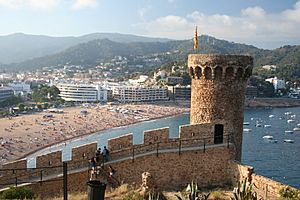 |
|||
|
|||
| Country | Spain | ||
| Community | Catalonia | ||
| Province | Girona | ||
| Comarca | La Selva | ||
| Area | |||
| • Total | 38.6 km2 (14.9 sq mi) | ||
| Elevation | 6 m (20 ft) | ||
| Population
(2018)
|
|||
| • Total | 5,584 | ||
| • Density | 144.66/km2 (374.7/sq mi) | ||
| Demonym(s) | Tossenc | ||
Tossa de Mar is a beautiful town in Catalonia, Spain. It is located on the sunny Costa Brava coast. The town is about 100 kilometers north of Barcelona. It is also about 100 kilometers south of the French border.
You can easily reach Tossa de Mar from Girona Airport. A long walking path called the GR 92 goes through Tossa de Mar. This path follows the Mediterranean coast of Spain. From Tossa de Mar, you can walk about 20 kilometers north to Sant Feliu de Guíxols. Or, you can walk about 14 kilometers south to Lloret de Mar.
Contents
A Look at Tossa de Mar's History
People have lived in the Tossa de Mar area for a very long time. There is proof of settlements from the Neolithic period, which was thousands of years ago. It seems people have lived here without stopping since then.
Ancient Settlements in Tossa de Mar
Between 400 and 100 BC, the first Iberian people settled here. Soon after, the Romans arrived in the 1st century AD. In 966 AD, Tossa was given to the Abbey of Ripoll by Count Miró of Barcelona.
Medieval Times and Growth
In 1187, Tossa received its official town rules from the Abbot of Ripoll. Around this time, a church was built on Mount Guardí. You can still see parts of this old church today. In the 12th century, the medieval town was surrounded by walls. A castle was also built on the highest point of Mount Guardí. This castle was later replaced by a windmill, and then by a lighthouse that still works today.
By the year 1500, people started building houses outside the town walls. This happened because the town was growing. This growth sped up in the 17th and 18th centuries. The town's shape stayed mostly the same until many tourists started visiting in the 1950s. In 1989, Tossa de Mar became the first place in the world to declare itself an anti-bullfighting city. This means they are against bullfighting.
What Drives Tossa de Mar's Economy?
Many people think Tossa de Mar was always a fishing town. But for a long time, its economy was mostly based on farming. People grew grapes and harvested cork. In the 18th and early 19th centuries, they even exported cork to the Americas.
Fishing in Tossa de Mar
Fishing has always been a smaller part of the town's economy. However, it has helped people earn money during tough times. A small fishing industry is still active today. The fish caught are often sold to local restaurants. They are also sold in fish markets in nearby towns like Blanes and Sant Feliu de Guíxols.
Exploring Tossa de Mar's Beaches
Tossa de Mar has three main beaches that are great for visitors:
- The Tossa Beach (Platja Gran): This is the main beach, right in front of the town center. The medieval castle stands on one side of it. It is about 380 meters long and 60 meters wide.
- La Mar Menuda: This beach is on the other side of the bay. It has many services, like sports equipment you can rent. Local police patrol the area on bicycles to keep everyone safe. This beach is about 180 meters long and 20 meters wide.
- El Codolar: This beach is located behind the old town walls.
Important Buildings and Sites
The Ancient Hospital of Sant Miquel
This old hospital was built in 1773. It was meant to help people who were poor. A wealthy man named Tomás Vidal i Rey, who made his money in America, founded it. The building has two floors and a central courtyard. Today, it is the town's cultural center. Next to it is the chapel of Sant Miquel, which has a beautiful baroque altar.
Roman Villa of Ametllers: A Glimpse into the Past
This ancient Roman villa (a large country house) dates from the 1st century BC to the 6th century AD. It was part of the Roman province called Tarraconensis. The villa had two main parts: one for living and one for farming. You can see how important it was by looking at the remains of its spa, its heating system, and its beautiful mosaics. There's also a base of a fruit press, used to make juices.
Pieces of mosaics, wall decorations (stucco), and sculptures show how rich the villa's owners were. Ceramic vases found here prove that they traded with other parts of the Mediterranean world. Farming tools, fishing gear, and loom tools (for weaving) tell us about their daily activities. Other items like hairpins and small spoons give us a peek into their everyday lives.
The Parish Church of Tossa de Mar
This church is dedicated to Vincent of Saragossa. It opened on November 29, 1775, after 20 years of building. It is one of the largest churches in the area. During big celebrations, it can hold everyone from Tossa de Mar. Sadly, much of the church's inside was damaged during the Civil War in 1936.
Inside, there is a chapel for Saint Sebastian, a saint loved by the people. This devotion started in the 15th or 16th century. Every year on January 20, people celebrate "Vot del Poble" (pledge of the people) in his honor. The retable (a decorated screen behind the altar) of the Rosary also survived the damage in 1936.
The Walled-in Old Town: Vila Vella
The "Vila Vella enceinte" is the only example of a medieval fortified town still standing on the Catalan coast. Its current look is from the late 14th century. It still has its original stone walls with battlements (notches for defense). It also has four turrets and three round towers with parapets (low protective walls).
At the highest point, where the lighthouse is now, there was once a castle. This castle belonged to the Abbot of the Monastery Santa Maria de Ripoll, who was the lord of the town until the early 1800s. This historic site was declared a national monument in 1931.
Inside the Old Town, you'll find charming, narrow, cobblestone streets. There's the Governor's House, which is now the Municipal Museum. You can also see the House of Holy Cloth ("Sant Drap"), a medieval hospital, and parts of an old Romanesque church and a Gothic church.
The Municipal Museum
The Municipal Museum is located in the Governor's House, inside the Vila Vella walls. This building used to be where the governors of Tossa de Mar lived. They ruled for the Abbots of the monastery Santa Maria de Ripoll.
The museum opened on September 1, 1935. It has an important collection of modern art. These works are by Spanish and foreign artists who visited Tossa de Mar in the 1930s. One famous piece is Celestial Violinist by Marc Chagall. The museum also has an archaeology section. This section displays items from the Paleolithic Period (Stone Age) to the late Middle Ages.
A special highlight is the mosaics found in the atrium of the Roman Villa of the Ametllers. These mosaics date from the late 4th to early 5th century.
See also
 In Spanish: Tosa de Mar para niños
In Spanish: Tosa de Mar para niños



